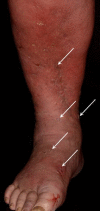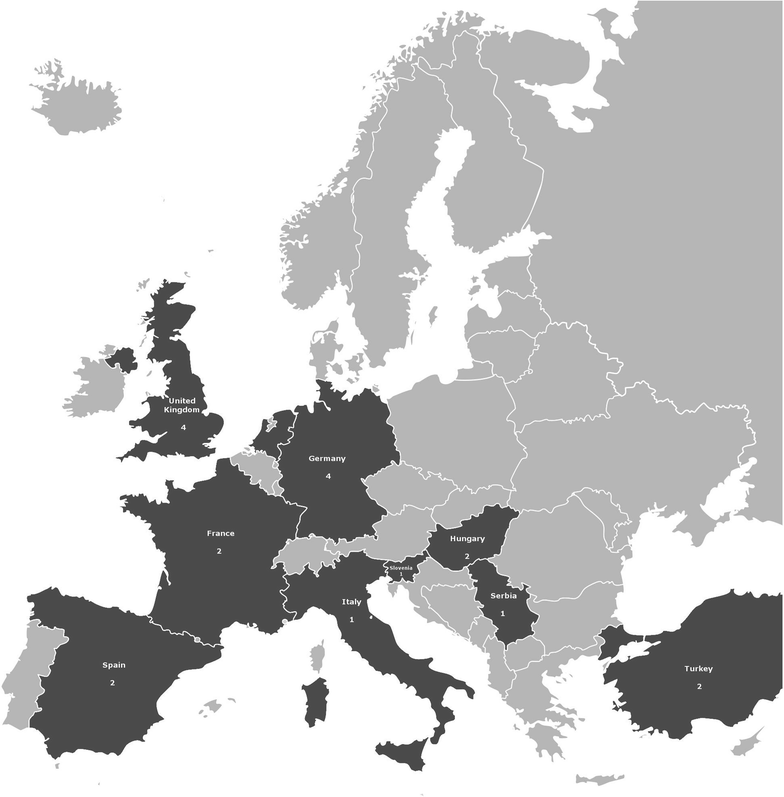Recurrent Scedosporium apiospermum mycetoma successfully treated by surgical excision and terbinafine treatment: a case report and review of the literature
- PMID: 28410611
- PMCID: PMC5391591
- DOI: 10.1186/s12941-017-0195-z
Recurrent Scedosporium apiospermum mycetoma successfully treated by surgical excision and terbinafine treatment: a case report and review of the literature
Abstract
Background: Scedosporium apiospermum is an emerging opportunistic filamentous fungus, which is notorious for its high levels of antifungal-resistance. It is able to cause localized cutaneous or subcutaneous infections in both immunocompromised and immunocompetent persons, pulmonary infections in patients with predisposing pulmonary diseases and invasive mycoses in immunocompromised patients. Subcutaneous infections caused by this fungus frequently show chronic mycetomatous manifestation.
Case report: We report the case of a 70-year-old immunocompromised man, who developed a fungal mycetomatous infection on his right leg. There was no history of trauma; the aetiological agent was identified by microscopic examination and ITS sequencing. This is the second reported case of S. apiospermum subcutaneous infections in Hungary, which was successfully treated by surgical excision and terbinafine treatment. After 7 months, the patient remained asymptomatic. Considering the antifungal susceptibility and increasing incidence of the fungus, Scedosporium related subcutaneous infections reported in the past quarter of century in European countries were also reviewed.
Conclusions: Corticosteroid treatment represents a serious risk factor of S. apiospermum infections, especially if the patient get in touch with manure-enriched or polluted soil or water. Such infections have emerged several times in European countries in the past decades. The presented data suggest that besides the commonly applied voriconazole, terbinafine may be an alternative for the therapy of mycetomatous Scedosporium infections.
Keywords: Antifungal susceptibility; Corticosteroid therapy; Cutaneous infection; Filamentous fungi; Immunosuppression; Scedosporium apiospermum.
Figures
Similar articles
-
Cutaneous hyalohyphomycosis by Scedosporium apiospermum in an immunocompromised patient.Mycoses. 2011 May;54(3):259-61. doi: 10.1111/j.1439-0507.2009.01797.x. Mycoses. 2011. PMID: 19889175
-
Case of cutaneous Scedosporium apiospermum infection successfully treated with voriconazole.J Dermatol. 2009 Feb;36(2):98-102. doi: 10.1111/j.1346-8138.2009.00597.x. J Dermatol. 2009. PMID: 19284454
-
[Scedosporium apiospermum disseminated infection in a single lung transplant recipient].Rev Iberoam Micol. 2011 Jul-Sep;28(3):139-42. doi: 10.1016/j.riam.2011.06.007. Rev Iberoam Micol. 2011. PMID: 21700235 Spanish.
-
Cutaneous Scedosporium apiospermum infection in an immunocompromised patient and a review of the literature.Acta Derm Venereol. 2005;85(2):156-9. doi: 10.1080/00015550410024553. Acta Derm Venereol. 2005. PMID: 15823912 Review.
-
Scedosporium apiospermum infectious scleritis following posterior subtenon triamcinolone acetonide injection: a case report and literature review.BMC Ophthalmol. 2018 Feb 13;18(1):40. doi: 10.1186/s12886-018-0707-4. BMC Ophthalmol. 2018. PMID: 29433463 Free PMC article. Review.
Cited by
-
Tryptophol Coating Reduces Catheter-Related Cerebral and Pulmonary Infections by Scedosporium apiospermum.Infect Drug Resist. 2020 Jul 22;13:2495-2508. doi: 10.2147/IDR.S255489. eCollection 2020. Infect Drug Resist. 2020. PMID: 32801788 Free PMC article.
-
Invasive and Subcutaneous Infections Caused by Filamentous Fungi: Report from a Portuguese Multicentric Surveillance Program.Microorganisms. 2022 May 11;10(5):1010. doi: 10.3390/microorganisms10051010. Microorganisms. 2022. PMID: 35630453 Free PMC article.
-
A case of cutaneous Scedosporium apiospermum infection in a patient on a janus kinase inhibitor.Skin Health Dis. 2023 Mar 10;3(3):e188. doi: 10.1002/ski2.188. eCollection 2023 Jun. Skin Health Dis. 2023. PMID: 37275418 Free PMC article.
-
Exploring the Siderophore Portfolio for Mass Spectrometry-Based Diagnosis of Scedosporiosis and Lomentosporiosis.ACS Omega. 2024 Oct 23;9(44):44815-44824. doi: 10.1021/acsomega.4c08257. eCollection 2024 Nov 5. ACS Omega. 2024. PMID: 39524635 Free PMC article.
-
Pulmonary Scedosporium apiospermum Infection with Pulmonary Tumorlet in an Immunocompetent Patient.Intern Med. 2018 Dec 1;57(23):3485-3490. doi: 10.2169/internalmedicine.1239-18. Epub 2018 Aug 10. Intern Med. 2018. PMID: 30101932 Free PMC article.
References
-
- Tammer I, Tintelnot K, Braun-Dullaeus RC, Mawrin C, Scherlach C, Schlüter D, et al. Infections due to Pseudallescheria/Scedosporium species in patients with advanced HIV disease—a diagnostic and therapeutic challenge. Int J Infect Dis. 2011;15:e422–e429. doi: 10.1016/j.ijid.2011.03.004. - DOI - PubMed
-
- Heath CH, Slavin MA, Sorrell TC, Handke R, Harun A, Phillips M, et al. Population-based surveillance for scedosporiosis in Australia: epidemiology, disease manifestations and emergence of Scedosporium aurantiacum infection. Clin Microbiol Infect. 2009;15:689–693. doi: 10.1111/j.1469-0691.2009.02802.x. - DOI - PubMed
Publication types
MeSH terms
Substances
LinkOut - more resources
Full Text Sources
Other Literature Sources
Miscellaneous




